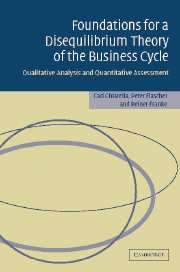 Foundations for a Disequilibrium Theory of the Business Cycle
Foundations for a Disequilibrium Theory of the Business Cycle Book contents
- Frontmatter
- Contents
- List of figures
- List of tables
- Foreword by J. Barkley Rosser, Jr.
- Preface
- Notation
- 1 Competing approaches to Keynesian macrodynamics
- Part I Textbook Approaches
- Part II Analytical Framework: Theory and Evidence
- 4 The Keynes–Metzler–Goodwin model
- 5 Calibration of three wage-price modules
- 6 Calibration of the full KMG model
- 7 Subsystems and sensitivity analysis of the KMG model
- Part III Monetary Policy
- References
- Index
5 - Calibration of three wage-price modules
Published online by Cambridge University Press: 22 September 2009
- Frontmatter
- Contents
- List of figures
- List of tables
- Foreword by J. Barkley Rosser, Jr.
- Preface
- Notation
- 1 Competing approaches to Keynesian macrodynamics
- Part I Textbook Approaches
- Part II Analytical Framework: Theory and Evidence
- 4 The Keynes–Metzler–Goodwin model
- 5 Calibration of three wage-price modules
- 6 Calibration of the full KMG model
- 7 Subsystems and sensitivity analysis of the KMG model
- Part III Monetary Policy
- References
- Index
Summary
Introduction
Chapter 4 has put forward our Keynes–Metzler–Goodwin model, the framework with which we will be concerned in the rest of the book. Assuming a neutral monetary policy, it has also presented a stability theorem, saying essentially that local asymptotic stability is ensured by sufficiently low values of a number of reaction parameters. This kind of proposition is, nevertheless, still very general. At the end of the chapter it was therefore concluded that, in order to ascertain the scope of the stability statements, a quantitative analysis would be necessary. In the first instance this means that a base scenario of numerical parameter values has to be established; subsequently we can examine how local stability is affected when these parameters are varied. In addition, of course, we will have to study the global dynamics generated by the base scenario.
Hence, the major task before us, which will occupy the next two chapters, is to find numerical values for the model's parameters that can serve as a base scenario. At the beginning a few words should be said about the general method, since numerical parameter setting can be approached in two different ways. Probably the more obvious one is econometric estimation. Here one takes the single equations or certain subsystems of the model and runs more or less sophisticated regressions. In the present context, however, this approach is beset with two difficulties.
- Type
- Chapter
- Information
- Foundations for a Disequilibrium Theory of the Business CycleQualitative Analysis and Quantitative Assessment, pp. 196 - 246Publisher: Cambridge University PressPrint publication year: 2005


